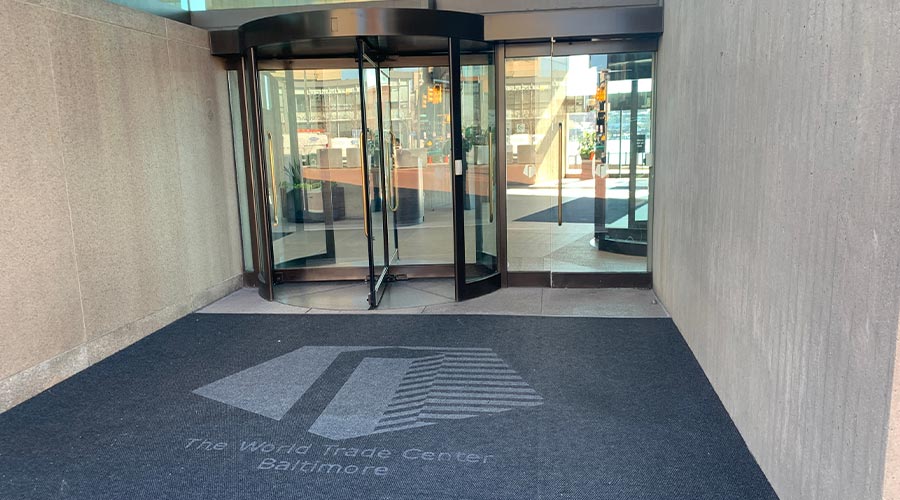
Always underfoot and often overlooked by those who traverse them, floor mats are one of the unsung heroes when it comes to facility safety — with the average person largely unaware of the critical role that they play. In fact, it’s not uncommon for facility cleaning managers or building service contractors (BSCs) to utterly dismiss their importance.
“Most believe matting only contributes to keeping entrances looking good, and not how matting can be a contributing factor for keeping the building clean, safe, and healthy,” says Mike Sawchuk, managing director of Sawchuk Consulting, St. Catharines, Ontario, Canada. “Most also do not fully understand what an effective matting program is, and the many tangible benefits it can provide.”
As Eric Cadell, vice president of Dutch Hollow Supplies, Belleville, Illinois, explains, for many facility cleaning managers or BSCs, matting is simply not on the top of their priority lists. As such, mats are often overlooked and are the last to be replaced when worn.
“Most people think a mat is just a mat. End users need proper education to understand the difference in types of mats and the functions they perform,” says Cadell. “It's important to educate clients that tossing a cheap carpet mat at an entrance to check a box isn’t the same as having a matting program.”
The benefits of matting, and subsequently, of a comprehensive matting program, are hard to ignore. Not only can proper matting reduce overall cleaning costs, but they can also protect against slips, trips and falls.
“Notice the word ‘trips’ — and not just ‘slips and falls’,” says Sawchuk. “Keeping floors dry and clean will help prevent slips and falls, and using matting where there is a transition from one flooring type to another, from a slightly higher level, or to help cover a cord, for example, will also help reduce trips.”
That could prove significant in multiple ways. According to National Floor Safety Institute (NFSI) figures provided by Stan Hulin, president/CEO of Future Facility Technology, Inc., Oregon City, Oregon, slips and falls are the primary reasons for lost time at work. They are the leading cause of worker’s compensation claims; and for people 55 years and older, slips and falls are the main cause of occupational injury.
Regardless of a facility’s geographic location, having a matting system in place is a necessity, adds Hulin. Facilities should be careful not to focus on entrance/exit matting alone, he cautions — there are other areas in the building where matting could also be useful.
“Matting systems go well beyond just the entries and exits of building,” explains Hulin. “They may also used for health and safety reasons, as well as protecting the flooring material surface.”
Installment Considerations
Although matting at entryways is important, end users must understand that not every entrance is designed to conform to the ideal in terms of matting guidelines, says Bill McGarvey, director of training and sustainability for Imperial Dade, Jersey City, New Jersey.
“In those situations, careful consideration of the area, soil, traffic types and flow need to be considered,” he says. “Generally speaking, matting should start outside of the building. It should typically transition into the entry and serve to dry potentially wet shoes once inside. Caveats to this might include healthcare settings and long-term care communities, which may opt for entry systems that tend to be more flush with surrounding elevations. This helps to prevent trip hazards for those with ambulation issues and/or assistance devices.”
Cadell concurs, adding that while understanding the building’s traffic and outside surfaces can help in determining proper mat placement, type and length for customers, typically the goal is to have at least 10-12 feet of matting at main entrances. This should consist of a scraper mat, followed by a wiper mat — a combination intended to remove large dirt/debris, fine particles and moisture.
LEED (the U.S. Green Building Council’s Leadership in Energy and Environmental Design) requirements are another consideration when working with customers, says McGarvey. These requirements call for at least 10 feet of matting at regularly used entrances. However, for him, the ideal length is up to 30 feet of entrance matting, starting outside and going into the facility.
“Outside matting is normally considered ‘scraper’ matting,” says McGarvey. “Inside vestibules or entryways is a blended version of part scraper/part absorbent mat. And inside the entrance would be primarily absorbent matting which can include the company/school/organization logo.”
Scraper matting, often constructed with a plastic or vinyl mesh-type material, is useful for removing heavy dirt such as gravel, rocks and other debris, says Hulin. In larger buildings, distributors often recommend a recessed scraper system.
“Entry grass or coco fiber absorbent matting removes excess moisture from the shoes,” he continues. “There are a variety of synthetic-fiber materials that perform the same task. These mats are often found in a vestibule that separates the exterior mat from the interior mat. Interior fiber mats [serve] the purpose of removing any remaining dirt and moisture from entering the building.”
To round out a full matting program, distributors should base recommendations on how the facility is used. Options include:
• Floor runner mats: Used to protect flooring in heavily trafficked areas, where lines form, or where rainfall may increase the risk of slip and falls
• Kitchen mats: Constructed from heavy-duty rubber, solid or with holes, they guard against slips and falls in often greasy environments
• Anti-fatigue mats: Made from soft rubber, they reduce fatigue for those having to stand a long period of time on hard surfaces
• Contamination control mats: Feature a tacky, adhesive surface to remove contaminants from shoes and wheels before entering classrooms and contaminant-sensitive areas
Promoting Facility Matting Plans in Facilities

 The Down and Dirty on Cleaning in Virus Season
The Down and Dirty on Cleaning in Virus Season How Surfactant Use is Expanding in Commercial Cleaning
How Surfactant Use is Expanding in Commercial Cleaning Operational Excellence Series 2025: Labor Strategies
Operational Excellence Series 2025: Labor Strategies
